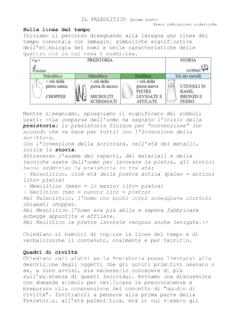Transcription of Human Evolution - Austin Community College District
1 Human Evolution single man ( Adam ) who lived sometime between 120,000 to 156,000 years ago modern humans are a relatively new species on the however, some Cameroonians and one African American planet tested have Y chromosomes not related to the above male ancestor; their Y-chromosome date to between oldest Homo sapiens fossil are ~200,000 yrs old 180,000 to 581,000 years ago about 100 B people have lived on earth so far or about 100,000 the Human genome is identical worldwide generations the Human genome is also ~98% the same as the today we can trace Human history using the males'.
2 Genome of chimps (our closest living relatives). Y-chromosome and mitochondrial DNA. the Y chromosome is passed to the males of every generation ! how did we get to that point? DNA in the mitochondria and passed the males & females of Primates every generation humans are in the order Primates and evolved from One misconception surrounding mitochondrial Eve is that since all women alive today descended in a direct unbroken female line from her, she must have been the only some early member of this group woman alive at the time.
3 However, nuclear DNA studies indicate that the size of the ancient Human population never dropped below tens of thousands. Other women earliest primates appeared ~65 MY ago during time of great living during Eve's time have descendants alive today, but at some point in the past each of their lines of descent did not produce a female, thereby breaking the diversification of mammal after the extinction of the dinosaurs mitochondrial DNA lines of descent. primates lived in trees (= arboreal) which selected results of mitochondrial genetic studies indicate for a specific group of traits important in Human that all living humans are related to a single Evolution : woman ( Eve ) who lived ~150,000 years ago in east Africa a.
4 5 digits sometimes with opposable thumb ! better gripping and dexterity results of Y-chromosomal inheritance studies indicate that all living humans are related to a b. nails rather than claws Genetics & Evolution : Human Evolution , Ziser Lecture Notes, 1 Genetics & Evolution : Human Evolution , Ziser Lecture Notes, 2. ! greater tactile sensitivity of fingertips more use of hands and arms for manipulation c. visual acuity may have moved to grasslands early could form sharp images had color vision ! seems to have eaten roots and seeds rather decreasing reliance on chemical senses than soft vegetation of plants d.
5 Greater maternal care modern Apes & Chimps longer, stronger mother-child relationships most are larger than other monkeys larger brain in proportion to size long arms & short legs ! brachiation e. tendency toward upright posture 4 modern genera at least could sit upright eg. gorillas, chimps Hominidae Humans and Human Ancestors (Hominins). primates are divided into 13 families which include uniquely Human traits the gibbons, marmosets, old world monkeys, tailed monkeys and the Hominidae which include not found in other living primates: the great apes : gorillas, chimps and us.
6 Used to be the family of man more recent genetic analysis a. habitually erect posture ! truly bipedal showed it should also include closely related primates b. lower limbs longer than forelimbs c. non-opposable larger toes apes first appeared ~20 million years ago (miocene). d. reduced canines e. bony chin a time when woodland savannas were replacing f. prominent nose forests and spreading across Africa, Europe g. relatively hairless and N. America h. much larger brain led to: ! abstract thinking earliest fossils were smaller than a chimp !
7 Speech and language ! use of complex implements tended toward bipedalism Genetics & Evolution : Human Evolution , Ziser Lecture Notes, 3 Genetics & Evolution : Human Evolution , Ziser Lecture Notes, 4. ! belief in supernatural and life after death ! importance of cultural Evolution Ardipithecus was probably in direct line of descent to us the evolutionary branch leading to humans probably began ~7 million years ago if so, they are separated from us today by over 300,000 generations molecular evidence indicates that Great Apes diverged from Human line ~10 MY ago (DNA is ~97% similar) 2.
8 Australopithecus sp. [ MY ago]. chimps diverged ~8 MY ago (DNA is ~98% similar) several species known (eg. Lucy & Taung Child);. some not in our direct line of ancestry it apparently wasn't a clean break ! both ancestral lines apparently continued to interbreed 4' tall, ~50 lbs for ~ MY after the split (based on DNA analysis). the first bipedal primate (the only one of the time). ! chimps share 98% of our genes walked upright (bipedal), ground walker ! 40 million molecular changes from them to us only 250,000 seem most responsible for the lived in open grasslands (eg.)
9 Lucy & footprints). physical and mental differences between us and them(AAS 9-1-05) ! better vision in grasslands !frees hands for weapons and harvesting the earliest fossils of Human ancestors appear in the fossil record ~ Million years ago still had relatively long arms 1. Ardipithecus ramidus ( Ardi ) [ MY] still probably spent lots of times in trees lived in the woodlands of E Africa no dramatic increase in brain size;. ~4' tall, weighed ~110 lbs had long arms, short legs with opposeable toes slightly larger brain than modern monkeys and apes spent most of their time in trees; ate, slept and raised (relative to size).
10 Young in trees but could easily walk on 2 legs and carry food in arms, relatively small canines and incisors compared to cruised the trees on all 4's probably several distinct species of the genus apes Genetics & Evolution : Human Evolution , Ziser Lecture Notes, 5 Genetics & Evolution : Human Evolution , Ziser Lecture Notes, 6. ! tooth size decreased some species began using primitive tools diet changed from largely vegetarian to more improving tool use in Human line probably led to the carnivorous development of speech !















